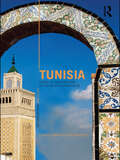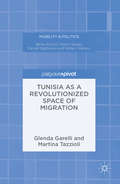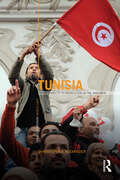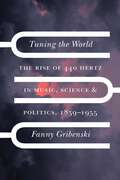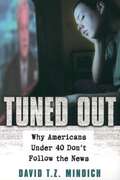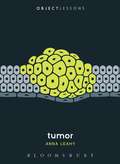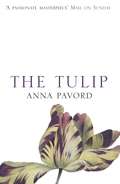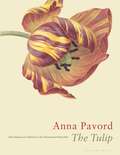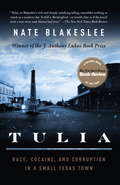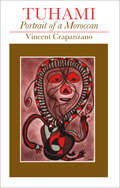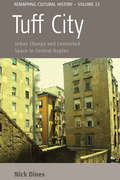- Table View
- List View
Tunisian Women's Writing in French: The Fight for Emancipation: From Ben Ali's Rise to Power to the Eve of the Tunisian Revolution, 1987-2011
by Sonia AlbaTunisian women's literary production in French, published or set between the years 1987 and 2011 from Tunisia's second president Zine El Abidine Ben Ali's rise to power to the eve of the Tunisian Revolution reveals the role of women, their political engagement, and their resistance to patriarchal oppression. A great deal of media and scholarly attention has focused on the role of women during the Tunisian Revolution itself, yet few studies have considered women's literary and active engagement prior to the uprising. By contrast, this book focuses specifically on the time period leading to the Revolution. The book is structured around three chapters, each focusing on a different form of writing and on a number of contemporary Tunisian writers who have chosen to express themselves in French. Sonia Alba explores the complex ways in which the authors have attempted to deal with those issues cultural, social and political most relevant to them. This is the first study of Tunisian women's writing in French to compare and contrast key themes in three different genres within a single study and within the conceptual framework of subaltern counterpublics. The work is enhanced by the inclusion of extracts from previously unpublished authors interviews. Tunisian Women's Writing in French is essential reading for all Francophone and Postcolonial scholars, and for scholars and students working in Contemporary Women's Writing.
The Tunisian Women’s Rights Movement: From Nascent Activism to Influential Power-broking (Routledge Studies on Gender and Sexuality in Africa)
by Jane D Tchaïcha Khedija ArfaouiTunisian women have received significant attention for their active participation in preserving and extending women’s rights since 2011. However, their activism and latest achievements should be considered not a recent phenomenon but rather part and parcel of a distinctive local history that has included women as agents of change. This book examines Tunisian women’s lived experiences, as individuals and as a group, within a sociohistorical framework that uncovers the enduring feminine footprint over centuries and eventually underpins and defines their most recent fight for gender equality in postrevolutionary Tunisia. The historic and current presentation of Tunisian women’s public and civic engagement distinguishes between different types of women’s objectives in order to examine women’s activism holistically as it evolved in the local context. The Tunisian Women’s Rights Movement will be of interest to students and scholars of Tunisia, North African, and Middle East Studies and gender in the Arab world.
The Tunisian Women’s Rights Movement: From Nascent Activism to Influential Power-broking (Routledge Studies on Gender and Sexuality in Africa)
by Jane D Tchaïcha Khedija ArfaouiTunisian women have received significant attention for their active participation in preserving and extending women’s rights since 2011. However, their activism and latest achievements should be considered not a recent phenomenon but rather part and parcel of a distinctive local history that has included women as agents of change. This book examines Tunisian women’s lived experiences, as individuals and as a group, within a sociohistorical framework that uncovers the enduring feminine footprint over centuries and eventually underpins and defines their most recent fight for gender equality in postrevolutionary Tunisia. The historic and current presentation of Tunisian women’s public and civic engagement distinguishes between different types of women’s objectives in order to examine women’s activism holistically as it evolved in the local context. The Tunisian Women’s Rights Movement will be of interest to students and scholars of Tunisia, North African, and Middle East Studies and gender in the Arab world.
Tunisia: Stability And Reform In The Modern Maghreb (The\contemporary Middle East Ser.)
by Christopher AlexanderThis book gives a concise yet comprehensive overview of Tunisia’s political and economic development from the mid-nineteenth century to the present. Written specifically for a non-specialist audience, the book examines the factors that make Tunisia one of the Arab world’s most stable and prosperous countries and one of its hardiest authoritarian orders. The author explores these themes in a way that sheds light on the political dynamics of the broader Arabic-speaking, Muslim world. Christopher Alexander draws on extensive primary and secondary research and on comparison with other countries in the region to provide the most up-to-date introduction to Tunisia's post-independence politics. Challenging the notion that Tunisia’s stability is rooted in a unique political culture, he argues that Tunisia’s stability reflects the pragmatic interests of a wide range of actors and the skillful maneuvering of the country’s two presidents. Concisely written chapters cover topics such as: state formation domestic politics economic development foreign relations colonialism An essential inclusion on courses on Middle Eastern politics, African politics, and political science in general, this accessible introduction to Tunisia will also be of interest to anyone wishing to learn more about this significant region.
Tunisia as a Revolutionized Space of Migration (Mobility & Politics)
by Glenda Garelli Martina TazzioliThis book explores the transformation of the Tunisian space of mobility after the Arab Uprisings, looking at the country’s emerging profile as a migratory “destination” and focusing on refugees from Syria, Libya, and Sub-Saharan countries; Tunisian migrants in Europe who return home; and young undocumented European migrants living in Tunis. This work engages with and contributes to the broader conversation on the migrations-crisis nexus, by retracing the geographies of mobility which are reshaping the Mediterranean region.
Tunisia as a Revolutionized Space of Migration (Mobility & Politics)
by Martina Tazzioli Glenda GarelliThis book explores the transformation of the Tunisian space of mobility after the Arab Uprisings, looking at the country’s emerging profile as a migratory “destination” and focusing on refugees from Syria, Libya, and Sub-Saharan countries; Tunisian migrants in Europe who return home; and young undocumented European migrants living in Tunis. This work engages with and contributes to the broader conversation on the migrations-crisis nexus, by retracing the geographies of mobility which are reshaping the Mediterranean region.
Tunisia: From stability to revolution in the Maghreb (The Contemporary Middle East)
by Christopher AlexanderThe first edition of Tunisia was released just nine months before the eruption of the Arab Spring. The most substantial period of political unrest felt by the Arab world in a half century originated in Tunisia, a fact that confounded expectations about Tunisian politics. This new edition builds upon the first edition’s overview of Tunisia’s political and economic development to examine how one of the region’s hardiest authoritarian orders was toppled by a loosely organised protest wave. Providing the most up-to-date introduction to Tunisia’s post-independence and post-Arab Spring politics, concisely written chapters cover topics such as: state formation domestic politics economic development foreign relations colonialism the Arab Spring; its factors and repercussions Key to this new edition is the examination of Tunisian history, politics and society alongside the subsequent upheaval following the outbreak of revolts in December 2010. It looks at how political and economic changes after 2001, including economic deterioration and rising inequality and corruption, had already begun to erode bases of Ben Ali’s government, and explores why Tunisia is the sole Arab Spring country to construct a democracy thus far, and the challenges that this new democracy still faces. An essential inclusion on courses on Middle Eastern politics, African politics, and political science in general, this accessible introduction to Tunisia will also be of interest to anyone wishing to learn more about this significant region.
Tunisia: From stability to revolution in the Maghreb (The Contemporary Middle East)
by Christopher AlexanderThe first edition of Tunisia was released just nine months before the eruption of the Arab Spring. The most substantial period of political unrest felt by the Arab world in a half century originated in Tunisia, a fact that confounded expectations about Tunisian politics. This new edition builds upon the first edition’s overview of Tunisia’s political and economic development to examine how one of the region’s hardiest authoritarian orders was toppled by a loosely organised protest wave. Providing the most up-to-date introduction to Tunisia’s post-independence and post-Arab Spring politics, concisely written chapters cover topics such as: state formation domestic politics economic development foreign relations colonialism the Arab Spring; its factors and repercussions Key to this new edition is the examination of Tunisian history, politics and society alongside the subsequent upheaval following the outbreak of revolts in December 2010. It looks at how political and economic changes after 2001, including economic deterioration and rising inequality and corruption, had already begun to erode bases of Ben Ali’s government, and explores why Tunisia is the sole Arab Spring country to construct a democracy thus far, and the challenges that this new democracy still faces. An essential inclusion on courses on Middle Eastern politics, African politics, and political science in general, this accessible introduction to Tunisia will also be of interest to anyone wishing to learn more about this significant region.
Tunisia: Stability And Reform In The Modern Maghreb (The\contemporary Middle East Ser.)
by Christopher AlexanderThis book gives a concise yet comprehensive overview of Tunisia’s political and economic development from the mid-nineteenth century to the present. Written specifically for a non-specialist audience, the book examines the factors that make Tunisia one of the Arab world’s most stable and prosperous countries and one of its hardiest authoritarian orders. The author explores these themes in a way that sheds light on the political dynamics of the broader Arabic-speaking, Muslim world. Christopher Alexander draws on extensive primary and secondary research and on comparison with other countries in the region to provide the most up-to-date introduction to Tunisia's post-independence politics. Challenging the notion that Tunisia’s stability is rooted in a unique political culture, he argues that Tunisia’s stability reflects the pragmatic interests of a wide range of actors and the skillful maneuvering of the country’s two presidents. Concisely written chapters cover topics such as: state formation domestic politics economic development foreign relations colonialism An essential inclusion on courses on Middle Eastern politics, African politics, and political science in general, this accessible introduction to Tunisia will also be of interest to anyone wishing to learn more about this significant region.
Tuning the World: The Rise of 440 Hertz in Music, Science, and Politics, 1859–1955 (New Material Histories of Music)
by Fanny GribenskiTuning the World tells the unknown story of how the musical pitch A 440 became the global norm. Now commonly accepted as the point of reference for musicians in the Western world, A 440 hertz only became the standard pitch during an international conference held in 1939. The adoption of this norm was the result of decades of negotiations between countries, involving a diverse group of performers, composers, diplomats, physicists, and sound engineers. Although there is widespread awareness of the variability of musical pitches over time, as attested by the use of lower frequencies to perform early music repertoires, no study has fully explained the invention of our current concert pitch. In this book, Fanny Gribenski draws on a rich variety of previously unexplored archival sources and a unique combination of musicological perspectives, transnational history, and science studies to tell the unknown story of how A 440 became the global norm. Tuning the World demonstrates the aesthetic, scientific, industrial, and political contingencies underlying the construction of one of the most “natural” objects of contemporary musical performance and shows how this century-old effort was ultimately determined by the influence of a few powerful nations.
Tuning the World: The Rise of 440 Hertz in Music, Science, and Politics, 1859–1955 (New Material Histories of Music)
by Fanny GribenskiTuning the World tells the unknown story of how the musical pitch A 440 became the global norm. Now commonly accepted as the point of reference for musicians in the Western world, A 440 hertz only became the standard pitch during an international conference held in 1939. The adoption of this norm was the result of decades of negotiations between countries, involving a diverse group of performers, composers, diplomats, physicists, and sound engineers. Although there is widespread awareness of the variability of musical pitches over time, as attested by the use of lower frequencies to perform early music repertoires, no study has fully explained the invention of our current concert pitch. In this book, Fanny Gribenski draws on a rich variety of previously unexplored archival sources and a unique combination of musicological perspectives, transnational history, and science studies to tell the unknown story of how A 440 became the global norm. Tuning the World demonstrates the aesthetic, scientific, industrial, and political contingencies underlying the construction of one of the most “natural” objects of contemporary musical performance and shows how this century-old effort was ultimately determined by the influence of a few powerful nations.
Tunesische Transformationen: Feminismus - Geschlechterverhältnisse - Kultur. Tunesisch-deutsche Perspektiven (Gender Studies)
by Steffi Hobuß Ina Khiari-Loch Moez MaataouiDie tunesische Gesellschaft stand vor allem während der Revolution von 2011 im Fokus europäischen Interesses. Doch wie haben sich die Kultur und vor allem die Geschlechterverhältnisse dort überhaupt entwickelt? Diesen Fragen geht der Band mit zwei Blickrichtungen nach: Zum einen wird die Transformation der Geschlechterverhältnisse in der Geschichte Tunesiens seit der Unabhängigkeit, der Diktatur und der Revolution 2011 bis zur Gegenwart analysiert. Zum anderen werden auf theoretisch-begrifflicher Ebene Transformationen des Feminismus und der Geschlechterbegriffe von einem Denken der Differenz und einer Politik der Repräsentation hin zu neueren dekonstruktiven und postkolonialen Gendertheorien erforscht. Betrachtet werden dabei vor allem die Bereiche der Künste, der Populärkultur sowie der Mode als wesentliche Medien der Transformation.
Tuned Out: Why Americans Under 40 Don't Follow the News
by David T. MindichAt a rate never before seen in American history, young adults are abandoning traditional news media. Tuned Out: Why Americans Under 40 Don't Follow the News examines the reasons behind this problem and its consequences for American society. Author David T. Z. Mindich speaks directly to young people to discover why some tune in while others tune out--and how America might help them tune back in. Based on discussions with young adults from across the United States, Mindich investigates the decline in news consumption over the past four decades. In 1972, 74% of Americans in their mid-30s said they read a newspaper every day. Today, fewer than 28% do so. The average viewer age at CNN is currently about 60 years old. And while many point to the Internet as the best hope for rekindling interest in the news, only 11% of young people list the news as a major reason for logging on--entertainment, e-mail, and Instant Messenger are ranked far higher on their list. Exploring the political, journalistic, and social consequences of this decrease in political awareness, Mindich poses the question: What are the consequences of two successive generations tuning out? He asserts that as young adults abandon the kinds of news needed to make political decisions, they have unwittingly ceded power to their elders. In an engaged and intelligent way, Mindich outlines these problems and proposes real solutions. An indispensable resource for anyone interested in media or politics, Tuned Out: Why Americans Under 40 Don't Follow the News is also ideal for undergraduate and graduate students in journalism, media, communication, political science, American studies, sociology, and education.
Tumor (Object Lessons)
by Anna LeahyObject Lessons is a series of short, beautifully designed books about the hidden lives of ordinary things. One in two men and one in three women will develop invasive cancer. Tumors have the power to redefine identities and change how people live with one another.Tumor takes readers on an intellectual adventure around the attitudes that shape how humans do scientific research, treat cancer, and talk about disease, treatment, and death. With poetic verve and acuity, Anna Leahy explores why and how tumors happen, how we think and talk about them, and how we try to rid ourselves of them. Object Lessons is published in partnership with an essay series in The Atlantic.
Tumor (Object Lessons)
by Anna LeahyObject Lessons is a series of short, beautifully designed books about the hidden lives of ordinary things. One in two men and one in three women will develop invasive cancer. Tumors have the power to redefine identities and change how people live with one another.Tumor takes readers on an intellectual adventure around the attitudes that shape how humans do scientific research, treat cancer, and talk about disease, treatment, and death. With poetic verve and acuity, Anna Leahy explores why and how tumors happen, how we think and talk about them, and how we try to rid ourselves of them. Object Lessons is published in partnership with an essay series in The Atlantic.
Tumblr (Digital Media and Society)
by Katrin Tiidenberg Crystal Abidin Natalie Ann HendryLaunched in 2007, tumblr became a safe haven for LGBT youth, social justice movements, and a counseling station for mental health issues. For a decade, this micro-blogging platform had more users than either Twitter or Snapchat, but it remained an obscure subculture for nonusers. Katrin Tiidenberg, Natalie Ann Hendry, and Crystal Abidin offer the first systematic guide to tumblr and its crucial role in shaping internet culture. Drawing on a decade of qualitative data, they trace the prominent social media practices of creativity, curation, and community-making, and reveal tumblr’s cultlike appeal and position in the social media ecosystem. The book demonstrates how diverse cultures can – in felt and imagined silos - coexist on a single platform and how destructive recent trends in platform governance are. The concept of “silosociality” is introduced to critically re-think social media, interrogate what kinds of sociality it affords, and what (unintended) consequences arise. This book is an essential resource for students and scholars of media and communication, as well as anyone interested in an influential but overlooked platform.
The Tulip: Twentieth Anniversary Edition
by Anna PavordTHE TULIP is not a gardening book. It is the story of a flower that has made men mad. Greed, desire, anguish and devotion have all played their part in the development of the tulip into the world-wide phenomenon it is today. No other flower has ever carried so much cultural baggage; it charts political upheavals, illuminates social behaviour, mirrors economic booms and busts, plots the ebb and flow of religious persecution. Pavord tells how the tulip arrived from Turkey and took the whole of Western Europe by storm. Sumptuously illustrated from a wide range of sources, this beautifully produced and irresistible volume will become a bible, a unique source book, a universal gift book and a joy to all who possess it.
The Tulip: Twentieth Anniversary Edition
by Anna PavordA twentieth anniversary edition of the classic, featuring new material by the author. Anna Pavord's internationally bestselling sensation, The Tulip, is the story of a flower that has driven men mad. Greed, desire, anguish, and devotion have all played their part in the development of the tulip into a worldwide phenomenon. Today, the United States alone imports three thousand million tulip bulbs each year. No other flower has ever carried so much consequence; it charts political upheavals, illuminates social behavior, mirrors economic booms and busts, plots the ebb and flow of religious persecution. Why did the tulip dominate so many lives through so many centuries in so many countries? Anna Pavord, a self-confessed tulipomaniac, spent six years looking for answers, roaming through Asia, India, and the Ottoman Empire to tell how a humble wildflower of the Asian steppes made its way to Turkey and from there took the whole of Western Europe by storm. Sumptuously illustrated from a wide range of sources, this irresistible volume has become a bible, a unique source book, a universal gift book, and a joy to all who possess it. This beautifully redesigned edition features a new Preface by the author, a completely revised listing of the best varieties of this incomparable flower to choose for your garden, and a reorganized listing of tulip species, to reflect the latest thinking by taxonomists.
Tulia: Race, Cocaine, and Corruption in a Small Texas Town
by Nate BlakesleeThis true story of race and injustice in a small west Texas town "resembles... a modern day To Kill a Mockingbird--or would, that is, if the novel were a true story and Atticus had won" (New York Times Book Review)In the summer of 1999, in the tiny west Texas town of Tulia, thirty-nine people, almost all of them black, were arrested and charged with dealing powdered cocaine. At trial, the prosecution relied almost solely on the uncorroborated, and contradictory, testimony of one police officer. Despite the flimsiness of the evidence against them, virtually all of the defendants were convicted and given sentences as high as ninety-nine years. Winner of the J. Anthony Lukas prize for excellence in nonfiction, Tulia is the story of this town, the bust, the trials, and the heroic legal battle that ultimately led to the reversal of the convictions. But the story is much bigger than the tale of just one bust. As Tulia makes clear, these events are the latest chapter in a story with themes as old as the country itself. It is a gripping, marvelously well-told tale about injustice, race, poverty, hysteria, and desperation in rural America.
Tulia: Race, Cocaine, and Corruption in a Small Texas Town
by Nate BlakesleeThis true story of race and injustice in a small west Texas town "resembles . . . a modern day To Kill a Mockingbird -- or would, that is, if the novel were a true story and Atticus had won" (New York Times Book Review) In the summer of 1999, in the tiny west Texas town of Tulia, thirty-nine people, almost all of them black, were arrested and charged with dealing powdered cocaine. At trial, the prosecution relied almost solely on the uncorroborated, and contradictory, testimony of one police officer. Despite the flimsiness of the evidence against them, virtually all of the defendants were convicted and given sentences as high as ninety-nine years. Winner of the J. Anthony Lukas prize for excellence in nonfiction, Tulia is the story of this town, the bust, the trials, and the heroic legal battle that ultimately led to the reversal of the convictions. But the story is much bigger than the tale of just one bust. As Tulia makes clear, these events are the latest chapter in a story with themes as old as the country itself. It is a gripping, marvelously well-told tale about injustice, race, poverty, hysteria, and desperation in rural America.
Tuhami: Portrait of a Moroccan
by Vincent CrapanzanoTuhami is an illiterate Moroccan tilemaker who believes himself married to a camel-footed she-demon. A master of magic and a superb story-teller, Tuhami lives in a dank, windowless hovel near the kiln where he works. Nightly he suffers visitations from the demons and saints who haunt his life, and he seeks, with crippling ambivalence, liberation from 'A'isha Qandisha, the she-demon. In a sensitive and bold experiment in interpretive ethnography, Crapanzano presents Tuhami's bizarre account of himself and his world. In so doing, Crapanzano draws on phenomenology, psychoanalysis, and symbolism to reflect upon the nature of reality and truth and to probe the limits of anthropology itself. Tuhami has become one of the most important and widely cited representatives of a new understanding of the whole discipline of anthropology.
Tuhami: Portrait of a Moroccan
by Vincent CrapanzanoTuhami is an illiterate Moroccan tilemaker who believes himself married to a camel-footed she-demon. A master of magic and a superb story-teller, Tuhami lives in a dank, windowless hovel near the kiln where he works. Nightly he suffers visitations from the demons and saints who haunt his life, and he seeks, with crippling ambivalence, liberation from 'A'isha Qandisha, the she-demon. In a sensitive and bold experiment in interpretive ethnography, Crapanzano presents Tuhami's bizarre account of himself and his world. In so doing, Crapanzano draws on phenomenology, psychoanalysis, and symbolism to reflect upon the nature of reality and truth and to probe the limits of anthropology itself. Tuhami has become one of the most important and widely cited representatives of a new understanding of the whole discipline of anthropology.
Tuhami: Portrait of a Moroccan
by Vincent CrapanzanoTuhami is an illiterate Moroccan tilemaker who believes himself married to a camel-footed she-demon. A master of magic and a superb story-teller, Tuhami lives in a dank, windowless hovel near the kiln where he works. Nightly he suffers visitations from the demons and saints who haunt his life, and he seeks, with crippling ambivalence, liberation from 'A'isha Qandisha, the she-demon. In a sensitive and bold experiment in interpretive ethnography, Crapanzano presents Tuhami's bizarre account of himself and his world. In so doing, Crapanzano draws on phenomenology, psychoanalysis, and symbolism to reflect upon the nature of reality and truth and to probe the limits of anthropology itself. Tuhami has become one of the most important and widely cited representatives of a new understanding of the whole discipline of anthropology.
Tuhami: Portrait of a Moroccan
by Vincent CrapanzanoTuhami is an illiterate Moroccan tilemaker who believes himself married to a camel-footed she-demon. A master of magic and a superb story-teller, Tuhami lives in a dank, windowless hovel near the kiln where he works. Nightly he suffers visitations from the demons and saints who haunt his life, and he seeks, with crippling ambivalence, liberation from 'A'isha Qandisha, the she-demon. In a sensitive and bold experiment in interpretive ethnography, Crapanzano presents Tuhami's bizarre account of himself and his world. In so doing, Crapanzano draws on phenomenology, psychoanalysis, and symbolism to reflect upon the nature of reality and truth and to probe the limits of anthropology itself. Tuhami has become one of the most important and widely cited representatives of a new understanding of the whole discipline of anthropology.
Tuff City: Urban Change and Contested Space in Central Naples (Remapping Cultural History #13)
by Nick DinesDuring the 1990s, Naples’ left-wing administration sought to tackle the city’s infamous reputation of being poor, crime-ridden, chaotic and dirty by reclaiming the city’s cultural and architectural heritage. This book examines the conflicts surrounding the reimaging and reordering of the city’s historic centre through detailed case studies of two piazzas and a centro sociale, focusing on a series of issues that include heritage, decorum, security, pedestrianization, tourism, immigration and new forms of urban protest. This monograph is the first in-depth study of the complex transformations of one of Europe’s most fascinating and misunderstood cities. It represents a new critical approach to the questions of public space, citizenship and urban regeneration as well as a broader methodological critique of how we write about contemporary cities.


